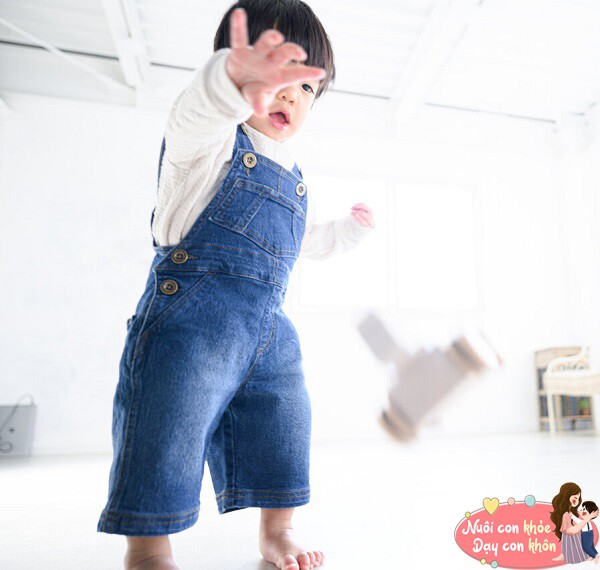Throwing things can sometimes make a mess in the house, but it can also be dangerous. So, why do children behave this way? A psychologist has analyzed this phenomenon from multiple perspectives, providing parents with practical guidance on how to address it.

Reasons Why Children Like to Throw Things
Tendency to Explore the Natural World
Children are naturally curious and explore their surroundings by touching, tasting, and throwing things. Throwing objects is a novel experience for them, as they can observe the trajectory, listen to the sounds upon impact, and witness the deformation of the object, thus satisfying their curiosity.
For instance, when given a toy car, a child will excitedly throw it away and then observe as it rolls and collides, producing a series of sounds.

Children are innately curious and explore their environment through touch, taste, and throwing.
Developing Muscle Control and Coordination
As children grow, they continuously develop muscle control and coordination. Throwing objects, especially at a target, is an excellent form of practice. Through repeated experiments, children gradually gain control over their strength and direction while improving hand-eye coordination.
For example, when a child throws a ball, they may initially miss the target, but after a few days of practice, they will be able to throw the ball more accurately. This sense of achievement keeps them engaged and motivated.
Expressing Emotions and Needs
Sometimes, throwing things can be a child’s way of expressing their emotions or needs. For instance, when a child feels angry, disappointed, or seeks attention, they may throw objects to convey this message.
Case in point: When a child becomes angry because their mother refuses to give them candy, they may pick up a nearby stuffed animal and throw it on the ground as a way to show their dissatisfaction and protest.

Throwing objects can sometimes be a child’s way of expressing their emotions or needs.
Imitation and Learning
Children are excellent imitators, and they may throw objects by mimicking adult behavior or scenes from TV. Additionally, if parents do not provide proper guidance or correction when a child throws things, the child may believe that this behavior is permissible.
Example: When a child sees their father throwing trash and it lands in the trash can, they find it fascinating and imitate this behavior by throwing away their toys as if they were trash.

How Parents Can Address Their Child’s Behavior of Throwing Things
Understanding and Respecting a Child’s Nature
Firstly, parents should understand that it is natural for children to throw things around and that they are not deliberately causing trouble. Therefore, when faced with this behavior, remain calm, be patient, and refrain from scolding your child harshly.
Suggestion: When your child throws something, gently say to them, “I know you enjoy this game, but let’s find a better way to play together.”

If space permits, create a designated throwing area for your child.
Providing Appropriate Toys and Alternative Activities
To satisfy your child’s need for exploration and movement, offer them suitable toys and activities that involve throwing, such as soft balls or frisbees. This will fulfill their need to throw while preventing them from damaging other objects.
Suggestion: Set up a special “throwing zone” with safe, appropriate toys for throwing and encourage your child to play in this designated area.
Teaching Children Appropriate Ways to Express Themselves
When your child expresses their emotions or needs by throwing things, teach them more appropriate ways to communicate. For instance, they can use language to express their dissatisfaction or ask for help.
Suggestion: When your child is angry and throws things, say to them, “I know you’re angry, and you can tell me what happened, and we can find a solution together.”
Establishing Clear Rules and Boundaries
Parents need to set clear rules and boundaries to inform their children about what can and cannot be thrown away. Additionally, children should be made aware of the consequences of throwing objects.
Suggestion: Create a simple rule book using pictures or words to indicate which objects are allowed to be thrown (such as soft balls) and which are not (such as knives). If your child breaks the rules, provide appropriate reminders or impose reasonable punishments.
Offering Guidance and Positive Reinforcement
When your child learns to control their behavior and stops throwing things, offer positive feedback and timely rewards. This can enhance their self-control and sense of achievement.
Suggestion: When your child refrains from throwing things all day, praise them: “You did a great job today by not throwing things around. Well done!” and give them a small reward, such as extra story time or a sticker of their favorite cartoon character.

Guide your child to choose safe objects for throwing.
Leading by Example
Your behavior significantly influences your child. Therefore, set a good example by refraining from throwing things at home.
Suggestion: In your daily life, pay attention to your words and actions, such as putting things back in their original places after use and not littering. This way, your child will subconsciously learn the correct behavior.
Children throwing things is a common phenomenon, but there are various reasons behind it. Parents need to understand and respect their child’s nature, respond to this issue by providing suitable alternative toys and activities, teach them appropriate ways to express themselves, set clear rules and boundaries, offer guidance and positive reinforcement, and lead by example.
With your guidance, attention, and patience, your child will gradually learn to control their behavior and become a well-behaved, polite, and responsible individual.

































